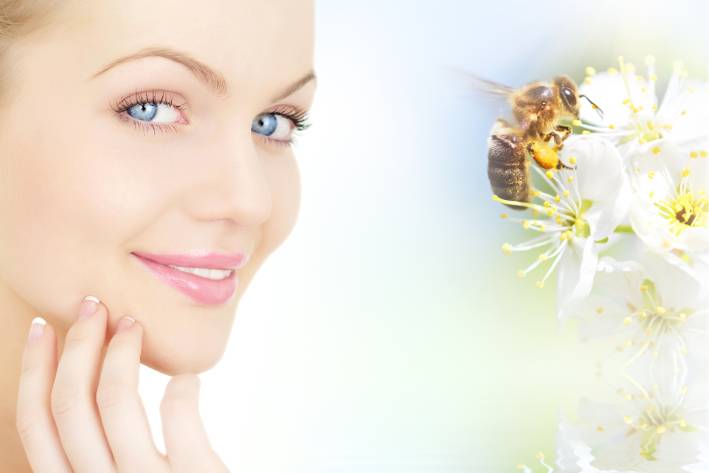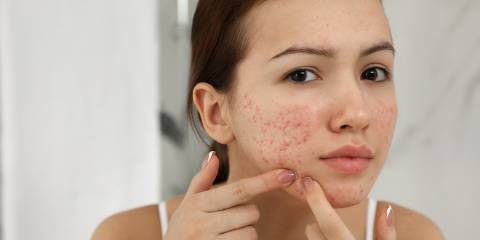Let’s consider the wondrous bee. The miracle worker that is not only a champion pollinator vital to our food supply but also the giver of many healing substances.
The most popular of these is honey, that golden and sweet substance that’s been a food for humans throughout history. Now this sticky substance has found its way into skin care.
But honey’s not the only substance this mighty insect gives us. Propolis, bee pollen, beeswax, royal jelly, and bee venom are other popular ingredients finding their way into topical products to get the skin healthy and glowing.
Here’s the buzz on the skin benefits of these gifts from the bee.
Bee Products for Skin Care
-
Honey
This tasty sweetener, made by bees from nectar and honeydew (a sticky, sugary substance made by aphids), is truly a healing substance. It contains at least 181 ingredients! These include:
- enzymes
- organic acids
- flavonoids
- essential oils
- proteins
- amino acids
- small amounts of vitamins and minerals
Uses
-
Healing
Not only a food, honey also has regenerative properties. It can help detoxify dermal tissue, improve skin elasticity and color, and smooth out wrinkles.
Honey helps speed up skin cells’ healing activities. In fact, the Manuka variety is so beneficial for wound healing that it’s now used in clinical settings.
For Acne
Honey can also help heal acne scars. Apply it every day to scars to help the healing process.
Always remove honey before going to bed. Remnants on the face can attract dust and dirt, which could lead to more breakouts.
-
Moisturizing
Honey also helps soften the skin. It adds moisture to dry areas, and it makes creams, lotions, and oils easier to rub in. It’s a balm for chapped lips, dry hands, and even frostbite.
In its sugared form, honey acts as a peeling agent.
Usage
If you decide to make your own skin care treatments, use only raw, unpasteurized honey. Heated varieties don’t have the same powerful nutritional and enzymatic properties.
Dab raw honey directly on the skin to help with acne, candida overgrowth, eczema, or psoriasis. Or use it as a natural exfoliator to reveal brighter skin.
Leave the honey on your skin for several minutes and then rinse it off.
-
Propolis
Commonly mixed in beeswax, propolis is also known as bee glue. It is a resinous substance that bees collect from tree buds, shrubs, and plants.
Propolis has a whopping 300-plus active compounds, including:
- esters
- phenolic acids
- flavonoids
- aromatic compounds
Uses
With antimicrobial, antiseptic, antioxidant, antiviral, and antifungal properties, propolis treats fungal infections, skin burns, and acne vulgaris.
Look for propolis in sunblock products and protective lipsticks, as it offers protection from ultraviolet radiation.
-
Bee Pollen
Bees bring pollen from plants back to the hives. Bee pollen has at least 200 active substances, including:
- vitamins
- flavonoids
- hydroxy acids
- unsaturated fatty acids
Uses
A strong antifungal, bee pollen is an anti-inflammatory and immuno-stimulating agent that can regenerate damaged skin tissue.
With its high content of flavonoids, it affects cell metabolism and boosts regeneration.
Bee pollen extracts and dried grains of bee pollen are sometimes added to natural cosmetics and skin care.
Look for skin products combining omega-rich fatty acids with bee pollen to help with scarring and sensitive skin.
-
Beeswax
Beeswax is a natural secretion formed from the wax-producing glands in worker bees’ abdomens. It’s used by bees to build honeycomb cells. For us humans, it’s an important cosmetic ingredient.
Uses
An emulsifying agent, beeswax forms the base for many lip balms, lipsticks, and creams because of its softening and lubricating properties, which also help prevent water loss from the skin.
Beeswax can help psoriasis, dermatitis, and the overgrowth of normal skin flora.
-
Royal Jelly
With such a regal name, it’s no surprise this ingredient is a supreme skin defender.
Uses
It has anti-inflammatory, anti-aging, antimicrobial, and regenerative properties to help repair skin tissues, wounds, and burns. It can also help heal shingles.
Find royal jelly as an ingredient in balms, lotions, and creams. Products with higher amounts of royal jelly tend to absorb well with no greasy residue.
-
Bee Venom
It sounds scary, but don’t let the name sway you from bee venom’s healing properties.
An effective, natural toxin rich in peptides, it offers antibacterial, anti-inflammatory, antifungal, and antimicrobial actions.
Uses
Many like bee venom for its natural botox-like properties, which help boost collagen production and improve elasticity.
Bee venom can be found in anti-acne products, as well as in treatments for wounds, psoriasis, and atopic dermatitis.
Bee venom’s recently been found effective for fighting wrinkles and photo-damaged skin.
Those with dry, aging, and acne-prone skin benefit most from this ingredient.
Look for bee venom-infused moisturizers to heal patches of itchy and dry skin.
Precautions: Bee Safe
Allergic reactions, though not common, can occur when using bee products.
Bee pollen is the most frequent allergen causing hypersensitivity, and beeswax is the least allergenic.
If you have allergies to bee venom, use caution with products containing honey and other bee ingredients.
Allergies to honey are rare. However, some individuals can experience skin rashes and eczema when applying royal jelly topically. Always do a patch test before using.





